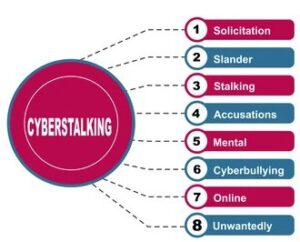
One morning you are woken by multiple text messages – each worse than the one before. You quickly open your social media account and are shocked at the things you see about you. Photos that have been manipulated, statements made out of context, even bold faced lies. Someone has been trolling you for weeks and has now made their unwanted advances public.
You are now a victim of cyber stalking.
According to WIKIPEDIA, Cyberstalking can be described as “Cyberstalking is the use of the Internet or other electronic means to stalk or harass an individual, group, or organization. It may include false accusations, defamation, slander and libel. It may also include monitoring, identity theft, threats, vandalism, solicitation for sex, doxing, or blackmail. The page goes on to inform the reader what each of the terms entail as well as describe the differences between Cyberstalking and other forms of internet harassment, such as Cyber-trolling and basic online harassment. However, regardless of the terminology used, each form of harassment causes difficult situations for the targets of those actions.
 ASSISTANCE AVAILABLE COR CYBER STALKING VICTIMS
ASSISTANCE AVAILABLE COR CYBER STALKING VICTIMS
The National Center for Victims of Crime partnered with the U.S. Department of Justice Office on Violence Against Women to create the Stalking Resource Center (SRC). Since its inception, the SRC has trained over 100,000 professionals who work with victims in all 50 states, two US Territories, the District of Columbia, the United Kingdom, and Germany and provided technical assistance to hundreds of communities seeking to enhance their response to stalking. The SRC is committed to continuing its national effort to promote awareness, action, and advocacy to enhance victim safety and hold stalking offenders accountable.
National Sexual Assault Hotline: National hotline, operated by RAINN, that serves people affected by sexual violence. Hotline: 800.656.HOPE or hotline.rainn.org. RAINN (Rape, Abuse & Incest National Network) is the nation’s largest anti-sexual violence organization. They have created and operates the National Sexual Assault Hotline (800.656.HOPE) in partnership with more than 1,000 local sexual assault service providers across the country and operates the DoD Safe Helpline for the Department of Defense. RAINN also carries out programs to prevent sexual violence, help survivors, and ensure that perpetrators are brought to justice.
National Domestic Violence Hotline: Through this hotline an advocate can provide local direct service resources (safehouse shelters, transportation, casework assistance) and crisis intervention. Interpreter services available in 170 languages. They also partner with the Abused Deaf Women’s Advocacy Center to provide a videophone option. Hotline: 800.799.SAFE.
Stalking Resource Center: The Stalking Resource Center is a program of the National Center for Victims of Crime. Their website provides statistics on stalking, information on safety planning and other resources.
Stalking Prevention, Awareness, & Resource Center (SPARC): SPARC mission is to make sure that the victim service providers (including domestic violence shelters and rape crisis agencies), campuses, law enforcement agencies, and other places where stalking victims come for help and support have the training and resources they need to better respond to victims and survivors.
